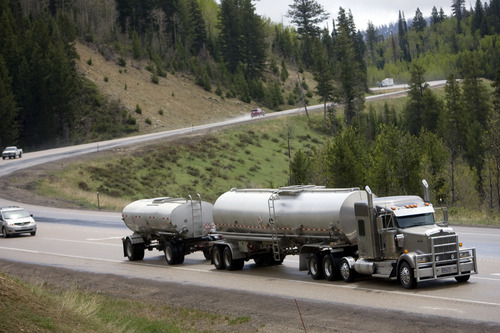This is an archived article that was published on sltrib.com in 2013, and information in the article may be outdated. It is provided only for personal research purposes and may not be reprinted.
Utah's Uinta Basin could see huge growth in oil and natural gas production — akin to the current boom in North Dakota — except for one problem: the remote area lacks adequate transportation to handle it.
Unless that problem is solved, $30 billion worth of oil and gas may go undeveloped there over the next 30 years. It could cost Utah's economy $10 billion, and prevent creation of nearly 27,000 jobs.
That's the conclusion of a study funded by the Utah Department of Transportation and local governments in Uintah and Duchesne counties, which was presented Friday to the Legislature's Infrastructure and General Government Appropriations Committee.
"As you look at the Uinta Basin, we have one primary artery. That's [U.S.] Highway 40," said Sen. Kevin Van Tassell, R-Vernal. It has only two lanes for much of its length, and super tanker trucks already travel it constantly a few minutes apart bringing crude to refineries near Salt Lake City.
The study looked at how much oil and gas production could be lost over the next 30 years because of transportation bottlenecks.
"We believe conservatively it is $30 billion," said Cory Pope, UDOT program development director. He added that the cost, in turn, to Utah's economy is about $10 billion in lost taxes and benefits to businesses, and a loss of nearly 27,000 jobs.
Pope said that also means Utah would be losing on average $180 million in taxes a year over that time, equivalent to about 4 percent of the state's annual tax collection.
Van Tassell asked lawmakers to fund $3 million to start another study to look at possible solutions to the transportation problems.
"I anticipate that we'll be looking at a number of things. We'll be looking at additional pipeline corridors. We'll be looking for utility corridors. We'll be looking at highway access and possibly a new highway access. I think we'll be looking at rail," he said. "I think we'll even be looking at increasing the airport to handle additional things. It's got to be a number of those."
Van Tassell said plans could also include building new facilities in the Uinta Basin to partially refine crude so it could be transported without heating. Currently, the crude turns into a wax without heat during transport.
He added that as production increases, "We're going to outstrip the capacity of refineries on the Wasatch Front," but trains or pipelines could allow transporting crude to distant refineries elsewhere. He said transporting crude by rail or pipeline is also cheaper than transporting it by truck.
Van Tassell said with $10 billion at stake for the state, it would be worth spending perhaps $1 billion to $2 billion on transportation improvements to get the rest. He added that he wants to handle planning and environmental analysis appropriately to avoid delays from environmental lawsuits.
Pope stressed that the study tried to be conservative in its estimates. It did not count on, for example, much production from oil shale, which so far has not resulted in much commercial production in Utah despite large reserves.
Van Tassell said that even looking just at the potential from traditional oil wells — if horizontal drilling techniques continues to be successful — production "will be similar to what's going on in North Dakota" with its recent boom, "if we can solve the transportation issue."



